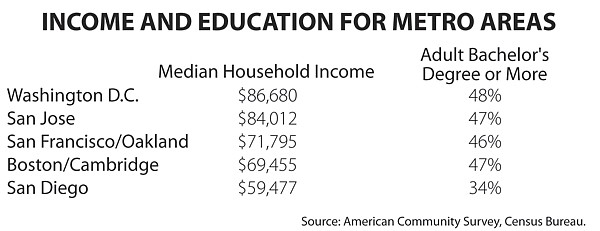 Facebook
Facebook
 X
X
 Instagram
Instagram
 TikTok
TikTok
 Youtube
Youtube

Brains and bucks go together. Cities with the highest percentage of adults with a bachelor’s degree or more tend to enjoy higher household incomes. Look no further than San Diego.
On September 20, the American Community Survey of the Census Bureau published new figures about cities and metropolitan areas: specifically, median household incomes and percentages of people 25 years of age or older with at least a bachelor’s degree.
San Diego stood out with median household income of $60,797 last year. Fully 41.1 percent of those over 25 had at least a bachelor’s degree, compared with 28.5 percent for the nation.
The bureau put out news releases for certain cities. San Diego had higher incomes and higher educational attainment than New York, Los Angeles, Chicago, Houston, Philadelphia, Phoenix, San Antonio, Dallas, Jacksonville, and Indianapolis. San Jose had higher income and Austin, Texas, higher educational attainment.
The media jumped on the bandwagon. MarketWatch.com said San Diego was one of the five richest cities, behind San Jose, San Francisco, Washington D.C., and Seattle.
The census’s findings appeared to validate a U.S. News University Connection story this year that listed San Diego ninth among “The Top 10 Smartest Cities in America.”
Feeling smug? Well, San Diego is smart, but not that smart. The statistics above relate to cities, not metropolitan areas. The Census Bureau released comparative data on metro areas, too, and those figures are most relevant. The San Diego–Carlsbad–San Marcos Metropolitan Statistical Area is the same as San Diego County, and it’s the nation’s 17th-largest metro area.
And on a metro basis, San Diego doesn’t do quite as well as the city. The percentage of adults with at least a bachelor’s degree is 34.2, and the median household income $59,477. But almost half the adults in the Washington D.C. metro area have at least a bachelor’s degree, and the median household income is highest in the nation at $86,680. (Lobbyists rake in oodles of money. Politicians do well, and so do their footmen.)
The San Jose metro area (essentially, Silicon Valley) sports the second-highest median household income at $84,012, with 47 percent of the adults having at least a bachelor’s degree. Not surprisingly, the Boston/Cambridge area has median income of $69,455, with 46.8 percent of adults having at least a bachelor’s. It’s the same story in San Francisco/Oakland, with median incomes of $71,975 and 45.9 percent educational attainment. Some other metro areas: Minneapolis/St. Paul, $63,352 and 40.6 percent; Seattle, $64,085 and 38.2 percent; and Raleigh, $59,197 and 43.7 percent.

Generally, they have the same characteristics: big universities in the area and lots of high tech industries. Boston/Cambridge and San Francisco/Oakland are classic examples, and on a smaller scale, Boulder, Colorado, is an eyepopper. No fewer than 62 percent of adults in the Boulder area have at least a bachelor’s degree, and median household income is $68,637.
The reverse is true as well. Only 15.8 percent of the folks in Brownsville, Texas, have a bachelor’s, and median family income is a mere $32,070. Less than 16 percent of the adults in Yuma and El Centro have degrees, and incomes are below $39,000.
The brainy folk don’t seem to mind shelling out big bucks for their daily bread. Boston’s cost of living is almost 40 percent higher than the nation’s. San Francisco’s is 66.5 percent higher, and San Diego’s almost 33 percent. According to Zillow, Boston’s metro area median home value is $310,500, San Diego’s $351,300, San Francisco’s $491,700, and San Jose’s a whopping $589,200. That’s against $152,100 for the nation as a whole.
Marney Cox, chief economist for the San Diego Association of Governments, says that the relationship between education level and income “is getting stronger. The recession was extremely hard on low-income households, and especially people with a high school degree or lower. A lot of blue-collar jobs, not necessarily requiring higher education but having middle income wages, have gone away or been reduced and haven’t come back.” And the higher-paying jobs that are being created require higher educational attainment.
One reason San Diego’s unemployment rate is significantly lower than the state’s is that when there are layoffs of lower-paid people, they retreat to their homes in south Riverside County and Tijuana, says Cox.
Corinne Wilson, research and policy lead for the Center on Policy Initiatives, says that one reason the city of San Diego does better than the county is that there are so many tech jobs and graduates in the La Jolla area. Conversely, look at the percentages of county residents below the poverty line: Vista, 20; Escondido, 21.6; National City, 22; and El Cajon, 23.6. “We did an analysis of private sector industry jobs from 2001 to 2010,” she says. County jobs growth was basically flat, and the jobs lost paid $62,000 a year while jobs gained paid $49,000. “For every high-wage job we create, we create eight low-wage jobs.”
Businesses are attracted to metro areas with a pool of educated people, says Kelly Cunningham, economist for the National University System Institute for Policy Research. In San Diego, the big research institutions such as Scripps Research Institute and Salk Institute spin off businesses that need educated employees. Cunningham points out that 6 percent of San Diego businesses and 11 percent of jobs are in technology. “Average pay in the tech industries is $100,000 per job, almost double the average job in the county of $51,000,” he says. Also, college grads are needed in small businesses: the county has 97,500 businesses and 96 percent have 50 or fewer employees. Unemployment rates are lower for college grads than for those with a high school degree or less.
“What we are seeing is a lot of jobs in research and development, related to biotech and life sciences, telecom, and engineering,” says Alan Gin, economist at the University of San Diego. ■


Brains and bucks go together. Cities with the highest percentage of adults with a bachelor’s degree or more tend to enjoy higher household incomes. Look no further than San Diego.
On September 20, the American Community Survey of the Census Bureau published new figures about cities and metropolitan areas: specifically, median household incomes and percentages of people 25 years of age or older with at least a bachelor’s degree.
San Diego stood out with median household income of $60,797 last year. Fully 41.1 percent of those over 25 had at least a bachelor’s degree, compared with 28.5 percent for the nation.
The bureau put out news releases for certain cities. San Diego had higher incomes and higher educational attainment than New York, Los Angeles, Chicago, Houston, Philadelphia, Phoenix, San Antonio, Dallas, Jacksonville, and Indianapolis. San Jose had higher income and Austin, Texas, higher educational attainment.
The media jumped on the bandwagon. MarketWatch.com said San Diego was one of the five richest cities, behind San Jose, San Francisco, Washington D.C., and Seattle.
The census’s findings appeared to validate a U.S. News University Connection story this year that listed San Diego ninth among “The Top 10 Smartest Cities in America.”
Feeling smug? Well, San Diego is smart, but not that smart. The statistics above relate to cities, not metropolitan areas. The Census Bureau released comparative data on metro areas, too, and those figures are most relevant. The San Diego–Carlsbad–San Marcos Metropolitan Statistical Area is the same as San Diego County, and it’s the nation’s 17th-largest metro area.
And on a metro basis, San Diego doesn’t do quite as well as the city. The percentage of adults with at least a bachelor’s degree is 34.2, and the median household income $59,477. But almost half the adults in the Washington D.C. metro area have at least a bachelor’s degree, and the median household income is highest in the nation at $86,680. (Lobbyists rake in oodles of money. Politicians do well, and so do their footmen.)
The San Jose metro area (essentially, Silicon Valley) sports the second-highest median household income at $84,012, with 47 percent of the adults having at least a bachelor’s degree. Not surprisingly, the Boston/Cambridge area has median income of $69,455, with 46.8 percent of adults having at least a bachelor’s. It’s the same story in San Francisco/Oakland, with median incomes of $71,975 and 45.9 percent educational attainment. Some other metro areas: Minneapolis/St. Paul, $63,352 and 40.6 percent; Seattle, $64,085 and 38.2 percent; and Raleigh, $59,197 and 43.7 percent.

Generally, they have the same characteristics: big universities in the area and lots of high tech industries. Boston/Cambridge and San Francisco/Oakland are classic examples, and on a smaller scale, Boulder, Colorado, is an eyepopper. No fewer than 62 percent of adults in the Boulder area have at least a bachelor’s degree, and median household income is $68,637.
The reverse is true as well. Only 15.8 percent of the folks in Brownsville, Texas, have a bachelor’s, and median family income is a mere $32,070. Less than 16 percent of the adults in Yuma and El Centro have degrees, and incomes are below $39,000.
The brainy folk don’t seem to mind shelling out big bucks for their daily bread. Boston’s cost of living is almost 40 percent higher than the nation’s. San Francisco’s is 66.5 percent higher, and San Diego’s almost 33 percent. According to Zillow, Boston’s metro area median home value is $310,500, San Diego’s $351,300, San Francisco’s $491,700, and San Jose’s a whopping $589,200. That’s against $152,100 for the nation as a whole.
Marney Cox, chief economist for the San Diego Association of Governments, says that the relationship between education level and income “is getting stronger. The recession was extremely hard on low-income households, and especially people with a high school degree or lower. A lot of blue-collar jobs, not necessarily requiring higher education but having middle income wages, have gone away or been reduced and haven’t come back.” And the higher-paying jobs that are being created require higher educational attainment.
One reason San Diego’s unemployment rate is significantly lower than the state’s is that when there are layoffs of lower-paid people, they retreat to their homes in south Riverside County and Tijuana, says Cox.
Corinne Wilson, research and policy lead for the Center on Policy Initiatives, says that one reason the city of San Diego does better than the county is that there are so many tech jobs and graduates in the La Jolla area. Conversely, look at the percentages of county residents below the poverty line: Vista, 20; Escondido, 21.6; National City, 22; and El Cajon, 23.6. “We did an analysis of private sector industry jobs from 2001 to 2010,” she says. County jobs growth was basically flat, and the jobs lost paid $62,000 a year while jobs gained paid $49,000. “For every high-wage job we create, we create eight low-wage jobs.”
Businesses are attracted to metro areas with a pool of educated people, says Kelly Cunningham, economist for the National University System Institute for Policy Research. In San Diego, the big research institutions such as Scripps Research Institute and Salk Institute spin off businesses that need educated employees. Cunningham points out that 6 percent of San Diego businesses and 11 percent of jobs are in technology. “Average pay in the tech industries is $100,000 per job, almost double the average job in the county of $51,000,” he says. Also, college grads are needed in small businesses: the county has 97,500 businesses and 96 percent have 50 or fewer employees. Unemployment rates are lower for college grads than for those with a high school degree or less.
“What we are seeing is a lot of jobs in research and development, related to biotech and life sciences, telecom, and engineering,” says Alan Gin, economist at the University of San Diego. ■
Comments